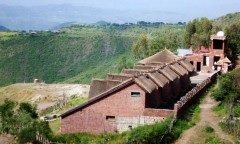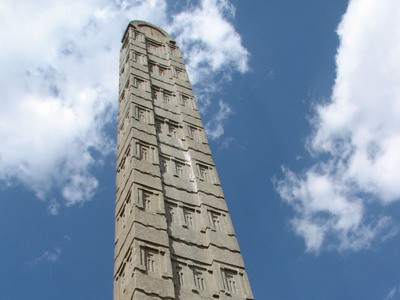The Blue Nile: Its Origin, Falls, and Gorge
Source of the Blue Nile
The traditional source of the Blue Nile, locally known as 'Abai', is a spring which feeds the little 'Abai', a stream which flows NE into Lake Tana from the highlands of 'Gishen'.
Lake Tana, the largest lake in Ethiopia, situated north of the beautiful town of Bahir Dar is the source from where the famous Blue Nile starts its long journey to Khartoum, and on to the Mediterranean.
There are 37 islands that are scattered about the surface of Lake Tana, out of which some 20 shelter churches and monasteries of immense historical and cultural interest.
Along the lakeshore bird life, both local and migratory visitors, make the site an ideal place for birdwatchers. The whole of the lake Tana region and the Blue Nile gorge host a wide variety of birds both endemic and migratory visitors.
Covering more than 3,600 square kilometers, Tana is Ethiopias largest lake. Known to the ancient Greeks as Pseboa, its sometimes stormy waters are traversed by papyrus reed boats, called tankwas, which differ little from those found in the tombs of the Pharaohs.
A boat trip on lake Tana is one of the most pleasant excursions for visitors. Those island and peninsulas of Lake Tana are most conveniently approached by boat trips arranged by Dinknesh Ethiopia Tour.
The Blue Nile River
The Blue Nile got the 'blue' part of its name because of its muddy color due to the huge amount of fertile soil it erodes from the Ethiopian highlands. Why they called it blue rather than the more logical color of brown, dark brown or even black is open to conjecture.
It is this spectacular flood of the Blue Nile that sets it apart from many other great river systems of the world. Each year during the heavy rains, the Blue Nile swells to over 50 times its dry season size and carries with it a staggering 140 million tonnes of rich, fertile silt as it rages, thick and brown, towards the Mediterranean sea.
The Blue Nile from the highlands of Ethiopia, and the White Nile from Lake Victoria meet in Khartoum, and merge in what Arab poets call 'the longest kiss in history', to form the Nile river.
For most of the year, the Blue Nile provides little water compared to the White Nile, but in summer it is very much the dominant tributary.
The Nile River is 6,700km long, and hence is the longest river in the world. Despite the fact that the Nile flows through one of the harshest deserts, and travels the last 2,400km without a single tributary, it never runs dry.
The Nile river is said to be the life of the Egyptians. There is an old saying that 'Egypt is the gift of Nile'. The entire long history of Egypt, even as far back as the days of the Pharoes and the Pyramids, is closely linked to the Nile river. This is still true even to the present day, as the Blue Nile is vital to the livelihood of Egypt. Almost 60% of the water that reaches Egypt originates from the Blue Nile branch of the great river.
The river is also an important resource for Sudan, where dams produce 80% of the country's power as well as irrigation for the Gezira Plain, a project delivering water to over 2 million acres. The Gezira Plain is most famous for the production of its high quality cotton. It also produces wheat, but animal feed crops dominate the production of this vast and rich farmland.
It is ironical that although the Blue Nile has such a big economic impact for Sudan and Egypt, Ethiopia as yet has not benefited from the Blue Nile. This is more eloquently put in an Ethiopian saying, "Ye Abayin lij wuha temat", which means "the daughter of Blue Nile is thirsty".
Besides the natural features of the Nile river, the fact that so many peoples and countries have vested interest in the river, makes it an extremely interesting geopolitical issue.
The Blue Nile Falls
The power of the Blue Nile may best be appreciated just thirty kilometers downstream from the point where the river first leaves Lake Tana. There, a rumble of sound fills the air and the green fields and low hills on either bank tremble to the Blue Nile Falls. It is one of the most dramatic spectacles on either the White or Blue Niles, a vision of natural strength and grandeur.
Four hundred meters wide in flood, the Blue Nile plunges forty-five meters down a sheer chasm to throw up a continuous mist that drenches the countryside up to a kilometer away. In turn, this gentle deluge produces rainbows that shimmer across the gorge under the changing arc of the sun - and a perennial rainforest. The pillar of cloud in the sky above, seen from afar, explains the local name for the falls, 'Tissisat', water that smokes.
The Blue-Nile Falls is the second largest of its kind in Africa, and is one of the best sceneries in the entire continent.
The Blue Nile Gorge
Within 30 km of its source at Lake Tana, the Blue Nile river enters a canyon which it does not leave for 400 km.
From all over the highlands, huge rivers pour into the Blue Nile Gorge. For a million years the Blue Nile has been carving this huge gash through the Ethiopian Highlands.
Nearly 20km wide and over 600km long, this is Africa's own Grand Canyon.
The Grand Canyon in Arizona, U.S.A. and the Blue Nile Gorge have their similarities and differences.
Similarities:
- Like the Grand Canyon, the Blue Nile Gorge exposes layers of rock laid down over hundreds of millions of years of earth history, with 150 million year old sandstones and limestone sandwiched between 800 million year old granites below and 20 million year old lava flows at the top. In spite of these similarities, the Blue Nile gorge is the more intimidating feature.
- The Blue Nile Gorge over much of its length is over 1500 km deep, just as deep as the Grand Canyon.
- Both have a great river flowing through them, the Blue Nile and the Colorado River.
The main Difference:
- The Blue Nile Gorge is a tremendous obstacle for travel and communication from the north half of Ethiopia to the southern half.
- There is another difference between the two rivers themselves: many people enjoy the raft ride down the Colorado through the Grand Canyon, but no one has ever floated down the Blue Nile and lived to brag about it.
Hence, although the two canyons have their similarities and differences, they are both magnificent to view and explore.






